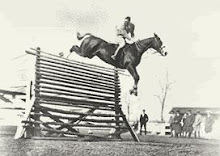The basic jumping position over the fence has been agreed upon across the globe, although there have been slight varieties. Before attempting to jump, you should be fully aware of your body coordination on the flat and in the air.
Before Jumping
Never attempt to jump in a dressage saddle. You must use a general purpose or a jumping saddle because your knees will be higher and more forward than your basic classical position. The forward cut of jumping saddles allows the knees to rest against knee pads and sometimes knee blocks for added security while jumping.
You will need to shorten your stirrups two or three holes than your usual flatwork length. This will give your legs more shock absorption span over fences.
Jumping is more strenuous than dressage although not as precise. Warm up thoroughly before jumping. Try to extend and collect your horse's paces in trot and canter during your warm up. This will aid the horse in establishing some self carriage and will help you control his strides on the approach of a fence.
Small Fences
Jumping smaller fences is always easier and less strenuous on your joints - and on your horse's joints of course. You should practice your jumping position over small fences before moving on to bigger fences. If you attempt a big fence first, you are risking your safety and your horse's comfort.
Jumping Position Between Fences
This subject has aroused much debate among riders. Some instructors teach their students to sit in the saddle between fences, and others teach them to maintain the forward seat. From my personal experience, I have found the forward position easier to maintain between fences than the upright position. Yet, you have to be aware of which position best suits your horse. Some horses become too excited and unmanageable when jumping; adopt an upright position to gain more control and to collect your horse. If your horse is too lazy - although this is highly unlikely when jumping (!) - adopt the forward seat to encourage him to perk up some energy.
Some riders choose to combine both the upright and the forward position when jumping a course. They maintain the forward position throughout on the flat, then sit upright a few strides on the approach of every fence to collect their horse. Again, this depends on your horse. If he has a tendency to run out or to stop, the upright position will give you more control by using your legs and your seat to prevent such behavior. There is a disadvantage to this though: if you are a beginner, you may become left out on the take off. In other words, the horse takes off sooner than you reach forward with the motion of the horse. The result is that you are left behind, weakening your seat and your knees, possibly causing a fall on the landing.
Jumping Position Over Fences
The diagrams below provide a rough guide about your position on the approach, take off, and landing. As you progress to jumping bigger and higher fences, your position will remain unaltered, although your will learn to be faster and more coordinated to cope with the initial shift from the ground through the air.
| APPROACH |
| |
| This diagram assumes that you are approaching the fence in an upright position. Your weight should be down through your heel to enable you to quickly absorb the flight. If your ankles are stiff, you may be left behind when the horse jumps.
|
| TAKE-OFF |
| |
| If you have approached in an upright position, you will have to be quick to compact your body to absorb the charge of the take-off. Approaching in the forward position will make this change in position almost automatic
|
| LANDING |
| |
| I cannot stress enough how important it is to close your legs around the horse when landing. If your knees are weak and loose, you are at risk of either loosing control momentarily after landing, or you are even at risk of falling. The bigger the fence, the more snug your knees have to be against the horse. Jumping saddles are equipped with a knee block for this purpose; it provides a secure block to prevent the knee from sliding too far forward. Some riders prefer to turn the toes out, gripping with the calves. Whichever method is more correct, it is important that you ensure a safe landing for yourself. |
The next two photos clearly illustrate the rider's position over a small fence during the take-off.
 | | An excellent position during take-off. The rider's heels are deep, his back is softly rounded and is parallel to the horse's back, and his hands are forward to accommodate the horse's motion. |
| | | |
 | | In this photo, the rider illustrates an incorrect position over the horse in take-off. Although his heels are deep, his upper body is erect and his hands are not following the horse. He is behind the movement. |
Conclusion
Jumping should be fun for you and your horse. Perfecting your jumping position is the first step of building up your skills for jumping. As mentioned previously, practice over small fences first until you are confident that you can tackle bigger ones. Having someone watch you who is equally knowledgeable will help you realize when you do it correctly and could raise the fences for you as you jump. Jumping for beginners is best done with other horses and riders around as the social support gives bags of confidence!
Be confidence, that is what you need to ride a horse. Mostly Jumping, Jumping needs braveness, confidence, and no fear. So don't ever be afraid when you see the pole, try to be confidence and know that will be success!!!




